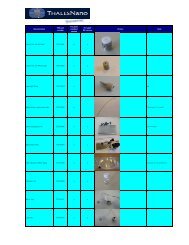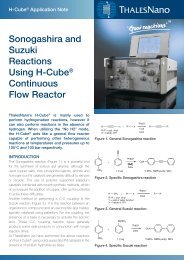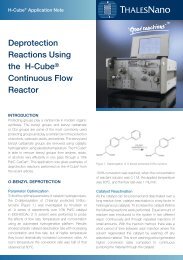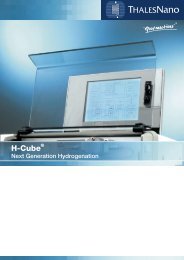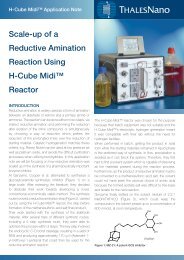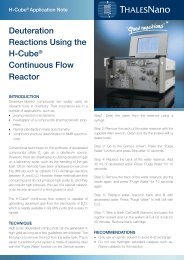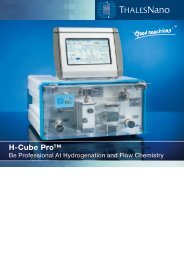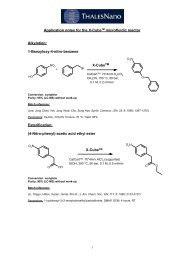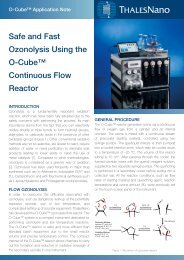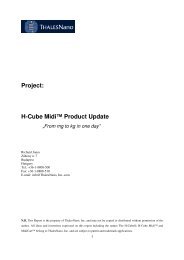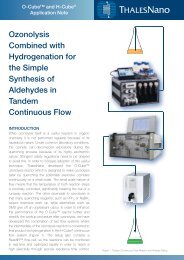Continuous Flow Synthesis - Selected Examples from ... - ThalesNano
Continuous Flow Synthesis - Selected Examples from ... - ThalesNano
Continuous Flow Synthesis - Selected Examples from ... - ThalesNano
You also want an ePaper? Increase the reach of your titles
YUMPU automatically turns print PDFs into web optimized ePapers that Google loves.
<strong>Continuous</strong> <strong>Flow</strong> <strong>Synthesis</strong> – <strong>Selected</strong><br />
<strong>Examples</strong> <strong>from</strong> the CDLMC-Graz<br />
Toma N. Glasnov and C. Oliver Kappe<br />
Christian Doppler Laboratory for Microwave Chemistry (CDLMC)<br />
and Institute of Chemistry, University of Graz<br />
Heinrichstrasse 28, A-8010 Graz, Austria<br />
toma.glasnov@uni-graz.at<br />
www.maos.net
Advantages of Microreactor/<strong>Continuous</strong> <strong>Flow</strong><br />
Chemistry<br />
• Very efficient mixing of the reactants (micromixing)<br />
• Rapid heat transfer and temperature control of the reaction system<br />
•High temperature/high pressure capability (back pressure regulation)<br />
• Control of residence/reaction times<br />
• Automated reaction optimization – on the fly changes<br />
• Immobilized catalysts/reagents<br />
• Hazardous reagents/conditions<br />
• Easy scale-up of a proven reaction by:<br />
• increase of time<br />
• reactor volume change<br />
• parallel processing (numbering up)<br />
• Automated purification possible by:<br />
• solid phase scavenging<br />
• chromatographic separation<br />
• liquid/liquid extraction<br />
• Integrated screening (lab-on-a-chip)<br />
Tube/Capillary<br />
Reactor<br />
Chip Microreactor
Microreactors/<strong>Flow</strong> Chemistry in Organic<br />
<strong>Synthesis</strong> – Recent Books<br />
Reviews on Microreactor/<strong>Flow</strong> Chemistry by: Hessel, Jensen, Kirschning, Ley, Roberge, Ryu, Verboom,<br />
Watts, Wirth, Seeberger......
Industrial-Scale Use of Microreactors to<br />
Produce Pharmaceuticals<br />
Numbering-Up Microreactors (DCM)<br />
Naproxcinod (NicOx)<br />
COX-Inhibiting Nitric Oxide-Donator (CINOD)<br />
for Relief of Pain and Inflammation - Osteoarthritis<br />
(under FDA review)<br />
DCM - NicOx Collaboration<br />
• nitration, neutralization and work-up in one flow step<br />
• cleaner and higher yields as in batch process<br />
• significantly lower waste generation<br />
• >100 tons/year production scale<br />
• FDA inspection of facility in due course<br />
Thayer, A. Chem. Eng. News 2009, 87 (March 16 issue), 17<br />
Braune, S. et al. (DSM) Chem. Today 2009, 27(1), 26
History: <strong>Flow</strong> Chemistry in Steel Capillary<br />
Reactors<br />
Reactor Combining HPLC and GC Parts<br />
stainless steel<br />
capillary, 0.7 mm i.d.<br />
<strong>Selected</strong> References (J. O. Metzger, 1978-1991)<br />
Chemistries<br />
• Redox chemistry<br />
• Radical reactions<br />
• Ester pyrolysis<br />
• Degradation of cellulose<br />
and chitin<br />
• Supercritical conditions<br />
Köll, K.; Metzger, J. Angew. Chem. 1978, 90, 802; Metzger, J.; Köll, K. Angew. Chem. 1979, 91, 74; Malwitz, D.; Metzger, J.O.<br />
Angew. Chem. 1986, 98, 747; Metzger, J. Angew. Chem. 1983, 95, 914; Klenke, K.; Metzger, J. O.; Lübben, S. Angew. Chem.<br />
1988, 100, 1195; Giese, B.; Farshchi, H.; Hartmanns, J.; Metzger, J. O. Angew. Chem. 1991, 103, 619.
Commercially Available “Mesofluidic“ Reactors<br />
for Organic <strong>Synthesis</strong><br />
<strong>Flow</strong>Syn<br />
www.uniqsis.com<br />
R-Series <strong>Flow</strong><br />
System<br />
www.vapourtec.co.uk<br />
Africa (FRX)<br />
www.syrris.com<br />
X-Flash<br />
Coflore ACR<br />
www.amtechuk.com<br />
www.thalesnano.com<br />
H-Cube O-Cube<br />
NanoTek<br />
www.advion.com<br />
Propel<br />
www.accendocorporation.com<br />
X-Cube
High-Temperature/Pressure <strong>Flow</strong> Reactor<br />
(X-Cube Flash)<br />
Stainless steel coil<br />
(SX316L, 1000 µm i.d.)<br />
Temperature 25-350 °C<br />
Pressure 50-180 bar<br />
<strong>Flow</strong> rates 0.5-10 mL/min<br />
Changeable size of reaction zone 4,8,16 mL<br />
4mL 8mL 16mL<br />
Res. time [min]: 0.4 to 8 0.8 to 16 1.6 to 32<br />
Razzaq, T.; Glasnov, T, N.; Kappe, C. O. Eur. J. Org. Chem. 2009, 1321; Chem. Eng. Technol. 2009, 32, 1702<br />
www.thalesnano.com
High-Temperature/Pressure <strong>Flow</strong> Chemistry<br />
Diels-Alder Reaction<br />
Reaction Optimization under <strong>Flow</strong> Conditions<br />
toluene<br />
0.8 mL min -1 , 60 bar<br />
4 mL coil
High-Temperature/Pressure <strong>Flow</strong> Chemistry<br />
Newman-Kwart Rearrangement: Microwave Conditions<br />
Moseley, J. D. et al. Tetrahedron 2006, 62, 4685<br />
Moseley, J. D.; Lenden, P. Tetrahedron 2007, 63, 4120<br />
<strong>Continuous</strong> <strong>Flow</strong> Results (4 mL Coil)<br />
NMP: 280 °C, 60 bar, 1 mL min -1 >99% (HPLC)<br />
Isolation difficult (aqueous)<br />
scDME: 300 °C, 80 bar, 1 mL min -1 >99% (HPLC)<br />
(bp. 85 °C, critical point: 263 °C/38 bar)<br />
Isolation by simple evaporation >99% yield
<strong>Continuous</strong> <strong>Flow</strong> Newman-Kwart Rearrangement<br />
Kinetic Analysis (HPLC)<br />
HPLC Conversion (%)<br />
100<br />
80<br />
60<br />
40<br />
20<br />
0<br />
NMP<br />
DME<br />
NMP<br />
100 150 200 250 300<br />
Temperature (°C)<br />
DME<br />
flow processing<br />
100-330 °C, 60-80 bar<br />
1 mL min-1 flow rate<br />
4 mL coil<br />
residence time 4 min
General <strong>Flow</strong> Chemistry Example:<br />
Heck C-C Coupling<br />
Literature Background<br />
Specific <strong>Flow</strong> Chemistry <strong>Examples</strong><br />
Stadler, A. et al. Org. Process Res. Dev. 2003, 7, 707<br />
Degussa Pd/C: Köhler, K. et al. Chem. Eur. J. 2002, 8, 622<br />
cf. Nikbin, N.; Ladlow, M.; Ley, S. Org. Process Res. Dev. 2007, 11, 458 (monolithic nanoparticles)<br />
cf. K. Mennecke, W. Solodenko, A. Kirschning, <strong>Synthesis</strong> 2008, 1589 (immobilized palladacycles)
Heck Chemistry (MW / <strong>Flow</strong>) –<br />
Homogeneous Catalysis with Pd(OAc) 2<br />
Aryl Iodide<br />
Entry Conditions Pd(OAc) 2 [mol%]<br />
<strong>Flow</strong>:<br />
0.01 mol % Pd(OAc) 2<br />
Et3N, MeCN<br />
170 °C, 0.4 mL min-1 (10 min res. time = 4 mL coil)<br />
Temp [°C] /<br />
Time [min]<br />
(94%)<br />
Conversion<br />
[%, GC-FID]<br />
Selectivity<br />
P/D/H [%, GC-FID]<br />
1 Batch/MW 0.4 150 / 2 >99 89 / 5 / 6<br />
2 Batch/MW 0.1 150 / 2 >99 93 / 2 / 5<br />
3 Batch/MW 0.05 150 / 5 >99 98 / 1 / 1<br />
4 Batch/MW 0.01 150 /25 >99 99 / 99 99 / 99 99 / 99 99 /
Boscalid (Nicobifen) – A Modern Fungicide<br />
Cl<br />
H<br />
N<br />
O<br />
Cl<br />
Boscalid<br />
N<br />
Production Plant<br />
Guaratingueta<br />
São Paulo, Brazil<br />
Boscalid Crystals<br />
On a Plant Leaf<br />
W. Krämer, U. Schrimer Modern Crop Protection Compounds, Wiley-VCH, Weinheim, 2007<br />
A. M. Rouhi, Chem. Eng. News 2004, 82(36), 49<br />
BASF Patents:<br />
• first launched in 2003/2004<br />
• expected sales up to €150 Million<br />
• 1000 ton/year production<br />
K. Eicken, (BASF AG, Ludwigshafen) EO05450992A2 1992; K. Eicken, N. Goetz, A. Harreus, E. Ammermann, G. Lorenz, H.<br />
Rang, (BASF AG, Ludwigshafen) EP0545099, 1993; K. Eicken, H. Rang, A. Harreus, N. Goetz, E. Ammermann, G. Lorenz, S.<br />
Strathmann (BASF AG, Ludwigshafen), DE19531813, 1997; K. Eicken, M. Rack, F. Wetterich, E. Ammermann, G. Lorenz, S.<br />
Strathmann (BASF AG, Ludwigshafen), DE 19735224, 1999; K. Eicken, M. Rack, F. Wetterich, E. Ammermann, G. Hardt, M.<br />
Rack, P. Schäfer (BASF AG, Ludwigshafen), WO Patent 97/33846 1997; S. Engel, T. Oberding (BASF AG, Ludwigshafen), WO<br />
Patent 2006/092429 2006
Suzuki C-C Coupling – MW & <strong>Flow</strong> Optimization<br />
Bases tested:<br />
DBU, DABCO, Et 3N<br />
K 2CO 3, Cs 2CO 3<br />
NaOMe, NaOEt, Kot-Bu<br />
MW Optimization<br />
<strong>Flow</strong> Optimization<br />
(Biotage Initiator/Optimizer) (X-Flash)<br />
Solvents tested:<br />
MeOH, EtOH<br />
n-BuOH, tert-BuOH<br />
THF, DMF, DME<br />
and water mixtures<br />
Catalysts tested:<br />
Pd/C<br />
Pd(OAc) 2<br />
Pd(PPh 3) 4<br />
Best Conditions:<br />
NaOH, TBAB, Pd(PPh 3) 4, THF:H 2O = 1:1, 160 °C, 15 min<br />
KOt-Bu, Pd(PPh 3) 4, t-BuOH:H 2O = 4:1, 160 °C, 15 min<br />
Isolated Yield after SP1-Chromatography:<br />
~ 91%<br />
Best Conditions:<br />
Kot-Bu,Pd(PPh 3) 4<br />
t-BuOH:H 2O = 4:1<br />
170 °C, 15 min<br />
1 mL/min flow rate<br />
16 mL coil<br />
Isolated Yield:<br />
~89%
Selective Nitro Group Reduction<br />
MW Optimization<br />
(Biotage Initiator/Optimizer)<br />
Hydrogen Source: Solvents tested:<br />
MeOH, EtOH<br />
THF:H 2O = 1:1<br />
t-BuOH:H 2O = 4:1<br />
Best Conditions:<br />
5 eq Cyclohexene, Pt/C, 150 °C, 30 min<br />
Isolated Yield after Flash-Chromatography:<br />
~ 81%<br />
Catalysts tested:<br />
Pd/C<br />
Pt/C<br />
<strong>Flow</strong> Optimization<br />
(H-Cube)<br />
Best Conditions:<br />
30 °C, atm H 2<br />
10% Pt/C<br />
t-BuOH/H 2O<br />
1 mL/min flow rate<br />
Crude Yield:<br />
93%
Amide Bond Formation<br />
Amide Bond Formation with PCl 3<br />
Amide Bond Formation with Commercial Acid Chloride
X-Flash & H-Cube – One-Pot - Two Steps<br />
Suzuki C-C Coupling Followed by Hydrogenation<br />
• Due to the presence of Pd ~ 17% (GC-MS) of dehlogenated side-product are observed<br />
• At the currently used conditions for the H-Cube (0.1 M solution) 12% of the Suzuki<br />
product are not being reduced – further optimization needed (going down with the<br />
concentration).<br />
• Isolated yield at the specified conditions after chromatography – 48%
X-Flash, X-Cube & H-Cube – One-Pot - Two Steps<br />
Suzuki C-C Coupling Followed by Hydrogenation<br />
• Pd scavenged out <strong>from</strong> the reaction mixture by QP-TU Resin<br />
• No over-reduced product observed.<br />
• Isolated yield at the specified conditions after chromatography – 77%<br />
Glasnov, T, N.; Kappe, C. O. Adv Synth. Cat. 2010, accepted
Scale-Up Comparing Microwave Batch<br />
and <strong>Flow</strong> Reactors<br />
Single-Mode Microwave Multimode Microwave X-Cube Flash<br />
Optimization<br />
< 20 mL<br />
Batch Scale-Up<br />
~ 1 L<br />
<strong>Continuous</strong> <strong>Flow</strong> Processing<br />
4, 8, 16 mL coils
Case Study: 2-Methylbenzimidazole Formation<br />
Conversion [%]<br />
Kinetic Study<br />
100<br />
T [°C]<br />
80<br />
60<br />
40<br />
20<br />
0<br />
0 5 10 15 20 25 30 35 40 45 50 55 60<br />
Time [min]<br />
60 °C<br />
100 °C<br />
130 °C<br />
160 °C<br />
200 °C<br />
>99 % conv.<br />
after<br />
25 9 weeks<br />
60 5 days<br />
100 5 h<br />
130 (2 bar) 30 min<br />
160 (4 bar) 10 min<br />
200 (9 bar) 3 min<br />
270 (29 bar) “1 s”
Batch Microwave Scale-Up:<br />
2-Methylbenzimidazole (200 °C, 5 min, 5 M)<br />
Temperature [°C]<br />
MW instrument<br />
Monowave 300<br />
Synthos 3000 (HF 100)<br />
200<br />
150<br />
100<br />
50<br />
0<br />
Reaction volume<br />
(mL)<br />
20<br />
16 × 60 = 960<br />
Heating Profiles<br />
Yield in g<br />
(%)<br />
9.44 (95)<br />
465.7 (98)<br />
Monowave<br />
Synthos, HF 100<br />
0 5 10 15 20 25<br />
Time [min]<br />
30 35 40 45 50<br />
Ramp/hold/cooling<br />
time (min)<br />
1/5/6<br />
15/5/30<br />
Overall processing<br />
time (min)<br />
12<br />
50
Converting Batch Microwave to <strong>Continuous</strong><br />
<strong>Flow</strong> Processing (X-Cube Flash)<br />
Benzimidazole <strong>Synthesis</strong><br />
Pyrazole <strong>Synthesis</strong><br />
Diels-Alder Cycloaddition<br />
Damm, M.; Glasnov, T, N.; Kappe, C. O. Org. Process Res. Develop. 2010, 14, 215
<strong>Continuous</strong> <strong>Flow</strong> Cu-Catalyzed Azide-Alkyne<br />
Cycloaddition (CuAAC, “Click Chemistry”)<br />
Heterogeneously Catalyzed “Click” Cycloaddition<br />
cf. Cu/C: Lipshutz, B. H. et al. Angew. Chem. Int. Ed. 2006, 45, 8235<br />
cf. flow click chemistry: Smith, C. D. et al. Org. Biomol. Chem. 2007, 5, 1559<br />
Bogdan, A. R.; Sach, N. W. Adv. Synth. Catal. 2009, 351, 849<br />
Fuchs, M.; Goessler, W.; Pilger, C.; Kappe, C. O., Adv. Synth. Catal. 2010, 352, 323<br />
Homogeneously Catalyzed “Click” Cycloaddition<br />
Dioxane<br />
130 °C, 4 mL min -1<br />
75% isolated yield<br />
DMF<br />
160 °C, 1.6 mL min -1<br />
86% isolated yield
<strong>Synthesis</strong> of Dibenzoazocines and Dibenzoazepines<br />
via Intramolecular A 3 -Coupling Reaction<br />
Boophane flava<br />
Suzuki C-C and A 3 -Coupling Sequential Synthetic Strategy<br />
R 1<br />
R 2<br />
n = 1, 2<br />
N R3 n<br />
R 4<br />
Bariwal J. B. et al. Org. Lett. 2010, 13, 2774<br />
R 1<br />
R 2<br />
Br<br />
B(OH) 2<br />
H<br />
N<br />
R3 n<br />
O<br />
R 4
<strong>Synthesis</strong> of Dibenzoazocines and Dibenzoazepines<br />
via Intramolecular A 3 -Coupling Reaction<br />
Microwave Approach<br />
<strong>Continuous</strong> <strong>Flow</strong> Approach<br />
Bariwal J. B. et al. Org. Lett. 2010, 13, 2774
Summary: A Novel Process Windows -<br />
High-Temperature/Pressure <strong>Flow</strong> Chemistry<br />
Translating microwave to flow chemistry: In a high-temperature/pressure<br />
microtubular flow device, many of the benefits inherent to microwave chemistry such<br />
as rapid heating/cooling and sealed vessel processing can be mimicked, including<br />
the generation of solvents in their supercritical state.<br />
Razzaq, T.; Glasnov, T, N.; Kappe, C. O. Eur. J. Org. Chem. 2009, 1321<br />
Razzaq, T.; Kappe, C. O. Chem. Asian J. 2010, 5, 1274<br />
Damm, M.; Glasnov, T, N.; Kappe, C. O. Org. Process Res. Develop. 2010, 14, 215
Ozonolysis
Christian Doppler Laboratory for<br />
Microwave Chemistry<br />
A Public-Private-Partnership Initiative (2006-2013)<br />
Christian Doppler Research Society (CDG)<br />
Austrian Science Fund (FWF)<br />
Austrian Research Promotion Agency (FFG)<br />
European Union COST, Land Steiermark<br />
BM:BWK, Österreichische Nationalbank (ÖNB)<br />
Biotage<br />
CEM<br />
Milestone<br />
Novartis, Abbott<br />
Boehringer Ingelheim<br />
Organon, Clariant
ZING Microwave & <strong>Flow</strong> Chemistry Conference<br />
Sharm el Sheikh, Egypt, February 25-28, 2011<br />
Chair: C. Oliver Kappe (University of Graz)<br />
www.maos.net<br />
Jonathan Moseley (AstraZeneca)<br />
Nicholas E. Leadbeater (Univ Conn)<br />
Fernando Albericio (Univ Barcelona)<br />
Erik Van der Eycken (Univ Leuven)<br />
Giancarlo Cravotto (Univ Torino)<br />
Peter Seeberger (MPI Potsdam)<br />
Jun-ichi Yoshida (Kyoto Univ)<br />
Dominique Roberge (Lonza)<br />
Mark Bagley (Cardiff Univ)<br />
Volker Hessel (IMM Mainz)<br />
Markus Niederberger (ETH Zürich) Thomas J. J. Müller (Univ Düsseldorf)<br />
Rafael Luque (Univ Cordoba)<br />
J. Santamaria (Univ Zaragoza)<br />
Mark Bradley (Univ Edinburgh)<br />
J. P. Robinson (Univ Nottingham)<br />
D. Kirschneck (Microinnova)<br />
F. Wiesbrock (TU Graz)<br />
www.maos.net



